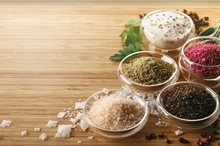 On February 11, New York City Mayor Michael Bloomberg announced that 21 companies had managed one or more voluntary commitments to reduce the amount of sodium in prepackaged or restaurant foods. The commitment was part of the National Salt Reduction Initiative (NSRI), the first-of-its-kind nationwide partnership to reduce sodium levels in U.S. foods.
On February 11, New York City Mayor Michael Bloomberg announced that 21 companies had managed one or more voluntary commitments to reduce the amount of sodium in prepackaged or restaurant foods. The commitment was part of the National Salt Reduction Initiative (NSRI), the first-of-its-kind nationwide partnership to reduce sodium levels in U.S. foods.Started in 2009, the partnership now involves more than 90 city and state health authorities and organizations and aims to reduce salt in packaged and restaurant goods by 25% during a five-year period through voluntary corporate commitments. It estimates that level of reduction will reduce the nation's sodium consumption by 20%. The program is modeled on a U.K. initiative which has managed to reduce salt levels by 40% or more in some products.
Food manufacturers that met the 2012 NSIR targets included Butterball, Furmano Foods, Goya Foods, Heinz, Ken's Foods, Kraft Foods, LiDestri Foods/Francesco Rinaldi, Mars Foods U.S., McCain Foods, Mondelez International, Red Gold, Snyder's-Lance, Unilever and White Rose. Restaurant chains that met or exceeded the sodium reduction targets were Au Bon Pain, Starbucks, Subway and Uno's Chicago Grill; while Delhaize America, Fresh Direct and Target Corp were among the successful retailers.
To demonstrate the difference in sodium amounts in foods, consider that a slice of Kraft American cheese has 18% less salt than it did three years ago, while Ragu Old World Style pasta sauce has 20% less. Each serving of Wishbone salad dressing has 37% less salt than three years ago, during which time Heinz has reduced the salt in its signature ketchup by 15%. Subway's Italian BMT sandwiches are 27% less salty.
Americans, as a whole, consume far more than health guidelines recommend. Overall average sodium consumption in the U.S. is estimated at 3,500mg per day, well above the limit of 2,300mg recommended by federal agencies and the Institute of Medicine. The average American male consumes nearly twice the amount of sodium as recommended.
New York officials, in making the announcement about the NSRI successes, were quick not to pin the blame for Americans' sodium consumption on consumers. "The problem is not the salt on the table. The problem is the salt on the label," rhymed city health commissioner Dr. Thomas Farley, one of several health officials who have stated that Americans get the vast majority of their salt from processed and prepared foods.
How did the various companies manage such a reduction in sodium levels? Au Bon Pain said it convinced suppliers to use fresh vegetables, whole grains and herbs, while Kraft Foods reduced the levels in several of its products by reformulating products to include potassium chloride. Admittedly, the incorporation of potassium chloride may not remove all of a product’s salt content (indeed, there is a level at which potassium chloride will result in a bitter or metallic flavor), but it did manage to help the company to reduce salt levels by 10-15%.
Sodium-reduction successes come as new research points to the benefits of reducing sodium intake. University of California, San Francisco, research finds that cutting the average American's sodium intake by 5% of a teaspoon a day could save hundreds of thousands of lives duringthe course of a decade. Researchers evaluated three sodium-reduction scenarios: gradual reduction by 40%, instant reduction of 40% and instant reduction to 1500mg per day (a decrease of nearly 60%). Published in the journal Hypertension, the research found the gradual reduction of salt is "an achievable public health goal that could save lives." Scientists estimated that such a gradual reduction could save 280,000-500,000 lives; a more rapid sodium reduction, they believe, would save 500,000-850,000.





